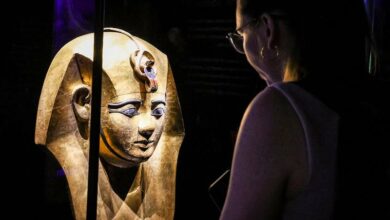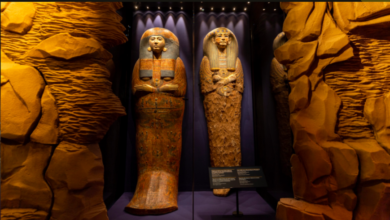Yesterday was the Muslim Brotherhood’s “Day of Rage.” While 28 marches planned to converge on Ramses Square in the heart of Cairo, a grid-iron army presence across the capital blocked off routes. Outbreaks of clashes by mid-afternoon turned into all-out violence in the Egyptian violence. The Health Ministry has said 173 people have been killed.
The protest I joined began at Sphinx Square. Two or three marches, one of them from the nearby Magfhera mosque, joined up. Not far down the road, army APCs lined the horizon – close to Mostafa Mahmoud mosque where at least 22 people were killed in street clashes with the police on Wednesday. It felt like the start of countless other marches or protests I have been on – Occupy Wall Street, British anti-austerity marches, trade union pickets – hopeful. Hopeful and a little futile.
When the thousands-strong crowd began to wind onto May 15 Bridge, a 20-year-old man climbed on top of a billboard above the motorway. He was trying to cut down the huge advertisement with Bassem Youssef’s face on it, smiling coyly on the motorists that were not there now. Running his small knife along the top of the 20-foot canvas, crowds cheered up at the man. But that was all he was able to do, skim the top of Youssef’s slicked-back liberal hair-do. Afterwards it felt like something done in vain, more a statement than an action with results. But the crowds cheered and chanted, and moved on down the road.
Over Zamalek and the Nile, occasionally someone would come out onto their balcony and wave an Egyptian flag or throw out a peace sign. Most people looked on in silence. One female marcher approached me. “Are you press?” she asked. “Please tell people that we are peaceful, that we do not have weapons.” What happened a couple of minutes later threw that statement into doubt.
As the march reached the downtown-side of May 15 Bridge, pro-Morsi marchers and loose groups of people on the Corniche below started throwing rocks at each other. One or two shots (from what sounded like a shotgun) rang out, I don’t know where from or from which side. Then a rapid volley of gunfire confirmed that there were automatic weapons in the crowd. It felt like almost right away and out of nowhere, men with AK-47s with keffiyehs around their heads and necks appeared in amongst the pro-Morsi protesters. Up the road, towards the October 6 Bridge intersection, young men were throwing rocks onto marchers below as they ran through in a line. People tried to take cover behind the metal barriers lining the road. There was a lot of confusion and screaming.
One man in a keffiyeh was firing a few metres behind me. He shot at the rooftops to the left and right of the bridge road. I couldn’t see any shooters there. Another shooter on the bridge fired at the rooftop stone-throwers, who then took cover and disappeared. There were shots that sounded like they were not coming from the march.
The group I was in started running forwards, further along the bridge. The whole area felt exposed. Gunmen were scanning rooftops. I stepped over a small bandage soaked in fresh blood. As we started running forwards, I looked to my right and saw a man’s head on the rooftop. I didn’t see him with a gun but a few seconds later bullets were hitting the building on the opposite side of the road, suggesting someone was firing from the right. The bullets were hitting maybe 15 feet above the road surface. Either the guy was a terrible shot – with all the gaps in the road barriers, and the hundreds of people passing by them it would not have been difficult to hit us – or he was trying to scare people and push them towards October 6 Bridge. This second theory would make more sense once we arrived there.
At the intersection, people were rushing onto October 6 Bridge. A quick glance behind confirmed that the police were waiting for crowds to move on to the main bridge, a line of three of four police trucks with armed officers waiting at the sides. It didn’t occur to me at the time that this might be a trap.
The march had stopped at the front. You could hear shooting away at the front, but it was not clear from where. The four or five gunmen I had seen in amongst protesters before were nowhere to be seen. I saw no guns in the crowds now. I presumed they were fighting out front. Every few minutes a scooter or motorbike would rush back from the invisible frontline with the injured, some of them looked seriously hurt. One man had a neck wound, blood gushing down his chest.
I looked back towards the police line behind the intersection and they had advanced. On a rooftop near the state media building two men had taken up position and were shooting. At first I thought they were police and were shooting protesters but the main body of the march was now in front of the direction they were aiming at. If they’d wanted to kill pro-Morsi protesters, there were hundreds of people to choose from bunched together. They may have been firing on protesters right at the back. Or they were firing on the police.
Sporadic tear gas clouds were now appearing on both sides of the pro-Morsi bunch on the bridge. I saw tear gas fired from a roof. Then the police rearguard started moving quicker, following pro-Morsi protesters as they ran down the bridge in the direction of Ramses. Men shouted down at residents watching underneath the bridge. Some scrabbled to reach the flimsy branches of a high-up tree to get off the bridge. Videos later emerged of people actually climbing off the bridge further down the road, despite the 20 or 30-odd-feet drop to the road below. People felt trapped, there was panic. A group I was in knelt and lay down to take cover. The crack of bullets coming from the direction of Ramses, and ricochets landing nearby, confirmed that someone was firing on protesters. Eyewitness reports later suggested armed beltageya (or thugs) were firing on protesters under the protection of police.
Minutes later, the police rearguard was firing birdshot onto the stragglers behind, where I was now trying to take cover. People were running in the direction of Ramses. At this point I ran across the road and made it clear I was press. I received a few birdshot rounds in the back until the advancing police heard me shouting “Sahafi! Sahafi!” They gestured me to leave, along with two other reporters who appeared to be reeling from the effects of the tear gas.
After running to the back of the police line, I was briefly held by an officer and beltageya. My passport and all of my equipment were taken.
I am ashamed I left.
I tweeted much of this account yesterday. Some Egyptians have accused me of being a liar, others have said I must be colour blind. Whether the guns I saw were pink, polka dot or brown and black, both sides were armed. Interim Prime Minister Hazem al-Beblawy has said the 173 casualties from yesterday were due to civilians clashing with Brotherhood supporters, Brotherhood supporters clashing with civilians.
I cannot deny this, although I suspect the reality was more complex and harder to swallow. I only briefly saw non-Brotherhood snipers. Either way, they appeared to be coordinating with the police to move protesters over the bridge where they could be dealt with in a more official capacity by the authorities. This is not black and white, right and wrong. I saw two groups that, if not trying to kill each other, saw no problem in putting civilians in the direct line of fire. That includes the police, as well as the gunmen amongst the pro-Morsi march.



